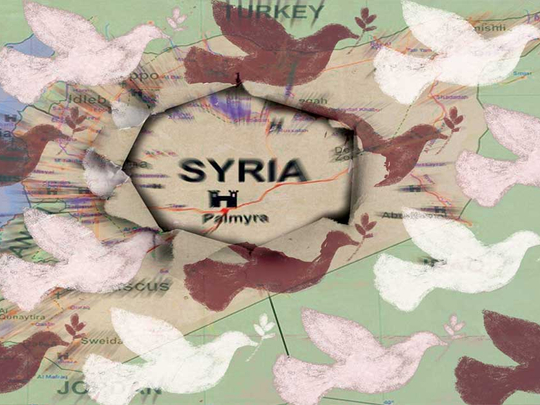
What’s going to happen over the next few days is probably the most important development in Syria’s eight-year ugly war. Tomorrow is a vital date for peace and war in Syria, in Syria’s Idlib province. If a deal on the suggested demilitarised zone in the province is successfully implemented, it could open the door for a settlement to end the bloodshed in the entire country.
At their summit meeting in the Russian city Sochi last September both Russian and Turkish presidents, Vladimir Putin and Recep Tayyip Erdogan, signed an agreement to establish a demilitarised zone in the province along the contact lines that separate the government troops and the opposition by October 15. Putin described the agreement as “a very good deal” (so did his Turkish counterpart) “that would prevent further bloodshed and the sides are actively working on fulfilling it.”
He was speaking at the plenary session of Russian energy conference recently. Though Iran’s President Hassan Rouhani was at Sochi, he was not a part of the Putin-Erdogan discussion, but the Russian president said he will be working further with Erdogan “with the support of Iran in this case.” The agreement specifically states that military hardware should be withdrawn from there (demilitarised zone), which will be controlled “by Russian and Turkish military patrols.”
Putin understands that he needs Iran’s input for the agreement to succeed even though there is no physical Iranian involvement in the province itself. But Tehran can create obstacles if the agreement on Idlib would develop into a prelude for a final settlement in the entire Syria that would eventually see the withdrawal of all foreign forces from the war-torn country.
In fact, the Russian president was very clear when he said that “we should pursue a goal that there would be no foreign forces in Syria at all, including Russian.”
Foreign interference
The question is whether Tehran will go along with Putin’s plan for pulling out of the country where it has invested so much to sustain the regime of Bashar Al Assad. This is part of Iran’s regional expansionist policy. The military arm of Iran’s Islamic Revolutionary Guard Corps (IRGC), known as the Quds Force (Failaq Al Quds), commanded by the infamous General Qassem Sulaimani, has been heavily involved in the Syrian war from the time Al Assad forces put down civil protests in the south of the country in 2011. It’s been reported that about 4,000 Iranian soldiers and high ranking officers have been killed in different battles in Syria since then. It is also estimated that 12 Iranian IRGC brigadier-generals have been killed and among them is Mohammad Jamali-Paqaleh who died in the outskirts of Damascus in 2013. Another officer, General Hassan Shateri, also of the IRGC, was killed while travelling from Beirut to Damascus.
Iran exercised full control over political decisions in Syria up until September 2015 when Russia began its own military build-up in the country, particularly at its airbase in Hemeimeem, near Latakia and in its naval base in the coastal city of Tartus. However, having established themselves firmly in Iraq following the withdrawal of the bulk of the American forces, General Sulaimani and other division officers are currently able to travel almost freely from Tehran via Baghdad through Damascus right to Hezbollah’s bases in Lebanon.
For Iran, Al Assad’s Syria is the most important ally in the Middle East as it is key to its strategy in the region. If Al Assad falls, the whole Iranian strategy will collapse.
Several thousands of Iranian soldiers and special forces were deployed to Syria, joining about 10,000 militia from its regional proxy, Hezbollah, and individual fighters assembled from Pakistan and Afghanistan.
On the other hand, it was Russia’s interference that really kept the regime on its feet. Its aid to the regime since September 2015, through direct military intervention, was the vital lifeline that sustained Al Assad. It was Russian air power that tilted the war in favour of the regime.
Therefore, it was this outside support that prolonged the war by saving the regime every time it was on the verge of collapse. Henceforth, the Syrian regime managed to consolidate its control over many territories west of the Euphrates, particularly after Aleppo fell into the hands of Al Assad’s forces in early 2016.
Now with two major players in the war trying to settle the conflict in the province of Idlib, would this mark the beginning of an era in which Syria returns to normality?
It is difficult given that more than 450,000 people have been killed, in addition to 5.5 million dispersed to neighbouring countries and beyond (almost three million are in Turkey alone), and another six million who have been internally displaced. Close to 1.5 million people are scattered in Idlib province itself.
Additionally, the UN estimates that about 13 million Syrians are currently in urgent need of humanitarian assistance. This is more than half the pre-war population.
In Idlib alone, some 2.9 million people (among them one million children) face an existential threat if a full-scale military operation is to start. However, if the Turkish-Russian plan works, the people of Idlib may just survive the catastrophe.
Mustapha Karkouti is a columnist and former president of the Foreign Press Association, London. Twitter: @mustaphatache.











